
- Index
- Listed By
- Material
- Size
- Style
- Abstract (20)
- Abstract, Modernism (6)
- Americana (5)
- Art Deco (9)
- Art Nouveau (4)
- Art, Realism (4)
- Dutch (4)
- Dutch, Realism (5)
- Expressionism (23)
- Folk Art (9)
- Impressionism (150)
- Impressionist (5)
- Modernism (12)
- Portraiture (6)
- Realism (163)
- Still Life (22)
- Traditional (10)
- Traditional, Realism (4)
- Victorian (18)
- Vintage (58)
- Other (476)
- Subject
- Unit Of Sale
Milt Gross Antique Modern Abstract Landscape Oil Painting Old Famous Cartoonist
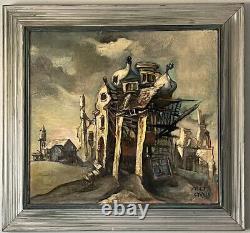
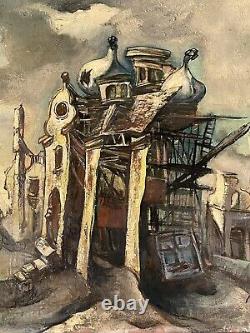
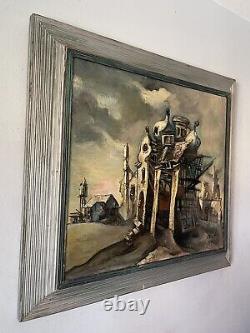
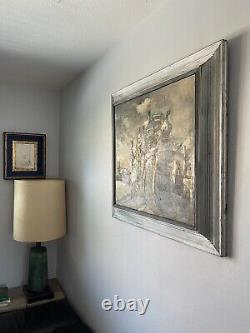
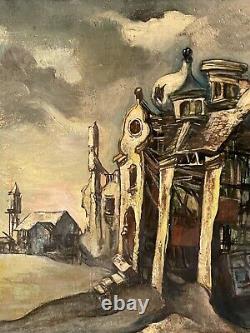

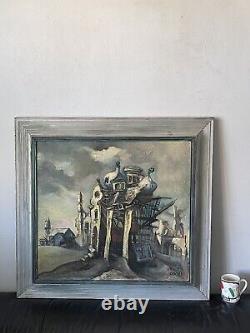

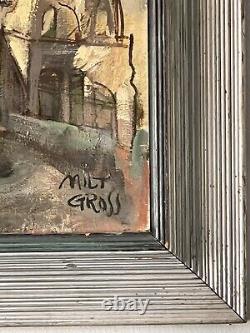


RARE AND CAPTIVATING ANTIQUE MID-CENTURY MODERN LANDSCAPE EXPRESSIONIST OIL PAINTING ON BOARD BY RENOWNED COMIC-CARTOONIST AND ILLUSTRATOR MILT GROSS. THIS WORK DEPICTS A MYSTERIOUS AND CREEPY OLD HOUSE IN THE MIDDLE OF NOWHERE. BRILLIANTLY RENDERED IN THE MODERNIST ABSTRACT STYLE. IT DATES AROUND THE 1940S. MILD SCRATCHES TO THE FRAME. DIMENSIONS: 31"H x 33"W.
Milt Gross was one of the true zanies of the cartoon world. He created a half-dozen nationally syndicated newspaper strips, including Count Screwloose and Daves Delicatessen. Born in the Bronx of New York in 1895, Gross left high school to accept a job as an office boy in the art department of Hearsts New York Evening Journal. This meant that Gross was able to associate with, and sometimes assist with, persons such as Tad Dorgan, Gus Mager, Harry Hershfield, Walter Hoban, and Tom McNamara. In the early 1920s, he changed to the New York World.
In addition to drawing strips like Banana Oil, he wrote and illustrated his own column for the Sunday edition. It was there that he began experimenting with the Jewish dialect. He recounted the adventures of the Feitlebum family, retold fairy tales and famous poems, and put great moments in history into dialect. The material was accepted, and in 1926, Doran published a book collection of the columns under the title Nize Baby. The 1920s was Grosss finest decade.
All kinds of people became fascinated with the American language and its colorful variations. These years saw the popularity of Amos and Andy, and the success of the writings of Dashiell Hammett, Ernest Hemmingway, and Ring Lardner. Gross reworked Hiawatha to read. On de shurrs from Geetchy Goony.
Stoot a tipee wit a weegwom. Frontage feefty fitt it mashered. Hopen fireplace -- izzy payments. His Jazz Age audience laughed and was captivated.
They were also taken by his cartooning in his columns, books, and strips. Gross was one of the most visually gratifying cartoonists of his day. His drawings are fun to look at, and have a lively, restless, sometimes frenzied, quality. While not an accomplished draftsman, he possessed a style that was entirely his own. His characters resembled those of no other artist.
It is possible that he may have been traumatized early in life by silent movie comedian Ben Turpin, since an unusually high percentage of his characters are cross-eyed. Sausage noses were another of Gross trademarks, so it was inevitable that he would eventually do a strip about a delicatessen. Not only the people, but also the furniture, buildings, autos, and trees were all distinctly his.
Unfortunately, his gags were not always equal to his artwork, and many strips and pages that are visual delights are not much fun to read. Gross often comes across as an impatient man, so anxious to get to the drawing that he settles for the first joke that comes to mind. He discovered early the comic possibilities of exposing hypocrites in the tradition of Opper and Goldberg, and he built numerous gags on the notion that people do not practice what they preach.That was, in fact, the sole premise of Banana Oil, which began as a daily strip and graduated to a top strip for the Nize Baby Sunday page that started in 1927. In one strip, a husband has a night on the town, for example, and awakens with a monumental hangover. His wife tells a visitor that "It was something he ate last night, " and the family cat observes, Thats a lotta Banana Oil!! " In another, a couple can barely afford their seaside vacation, but the wife tells a fellow vacationer that her husband "insisted on Europe this year, but I dont like the excitement, " while in the background the husband mutters, "Banana oil!!
What Gross was using was the basic idée that Jimmy Hatlo later parlayed into the successful Theyll Do It Every Time panel. Grosss next feature, Count Screwloose, also had an idée fixe, the same one he had used in Banana Oil. The Sunday page replaced Nize Baby in February 1929. Each and every week, the diminutive and cross-eyed, Count escaped from the Nuttycrest Asylum to try his luck in the outside world.
Each and every week, he encountered such lunacy or hypocrisy that he decided to climb over the wall to the relative sanity of Nuttycrest. Almost every final panel would show Screwloose requesting his faithful pooch, Iggy, keep an eye on me! Gross switched to King Features in 1920 and drew three alternating daily titles.
Again, he relied on the repetition of simple situations. In I Did It and Im Glad, people take revenge on boors and pests; in Draw Your Own Conclusions, the final panel left the focal character in a dire predicament. The Meanest Man was the most bizarre, starring a cloaked and slouch-hatted little villain who did bad deeds -- seeing to it that kids who get Lindberghs autograph have vanishing ink in their pens, giving a hungry dog a rubber sausage that explodes in its face, locking a little henpecked husband in his house so his big wife can lambaste him, and so on. It is hard to tell why such a nasty character, who always won out and never got his comeuppance, appealed to Gross, who was supposedly a gentle and kindhearted man. This triple-threat strip ended in 1931 to be replaced by Daves Delicatessen.
Dave was a likable bumbler, a softie who tried to act tough, but always ended up giving hungry people free food, getting taken in by conmen, generally making a fool of himself in front of his friends, wife, and community. After a while, Gross introduced continuity, usually parodies of the adventure fare of the period: Dave trekked to Africa, joined the Foreign Legion, and tangled with crooks.
Early in 1935, Dave drifted away, and Count Screwloose, who had been sharing the Sunday with him, took over. The daily had already folded.As the 1930s progressed, Gross came up with several new features. Gross was then living in the Los Angeles area, and involved with the movies. The dependable Bob Dunn ghosted much of the comic work he signed in the last years of the decade.
During the Second World War, Gross turned again to dialect prose, doing a column called Dear Dollink for Hearsts Sunday Pictorial Review. After the war, he showed up in comic books, drawing four pages of comments on the news for Picture News, a nonfiction comic book.
In the summer of 1947, Milt Gross Funnies appears, written, drawn, and apparently published by Gross. The first issue showcased Thats My Pop!His saga of a likable, but neer-do-well father and his family. The drawing was up to Gross 1920s standards and the layouts completely unorthodox. The second issue, which proved to be the last, included a variety of Gross old characters, including Count Screwloose. His final work appeared in Giggle Comics and Hi-Jinx.
He suffered with a heart condition and died in 1953 while returning from a Hawaiian vacation with his wife.
